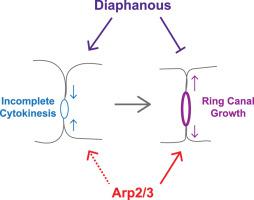当前位置:
X-MOL 学术
›
Dev. Biol.
›
论文详情
Our official English website, www.x-mol.net, welcomes your feedback! (Note: you will need to create a separate account there.)
The Arp2/3 complex and the formin, Diaphanous, are both required to regulate the size of germline ring canals in the developing egg chamber.
Developmental Biology ( IF 2.7 ) Pub Date : 2020-01-13 , DOI: 10.1016/j.ydbio.2020.01.007 Josephine Thestrup 1 , Marina Tipold 1 , Alexandra Kindred 1 , Kara Stark 1 , Travis Curry 1 , Lindsay Lewellyn 1
Developmental Biology ( IF 2.7 ) Pub Date : 2020-01-13 , DOI: 10.1016/j.ydbio.2020.01.007 Josephine Thestrup 1 , Marina Tipold 1 , Alexandra Kindred 1 , Kara Stark 1 , Travis Curry 1 , Lindsay Lewellyn 1
Affiliation

|
Intercellular bridges are an essential structural feature found in both germline and somatic cells throughout the animal kingdom. Because of their large size, the germline intercellular bridges, or ring canals, in the developing fruit fly egg chamber are an excellent model to study the formation, stabilization, and growth of these structures. Within the egg chamber, the germline ring canals connect 15 supporting nurse cells to the developing oocyte, facilitating the transfer of materials required for successful oogenesis. The ring canals are derived from a stalled actomyosin contractile ring; once formed, additional actin and actin-binding proteins are recruited to the ring to support the 20-fold growth that accompanies oogenesis. These behaviors provide a unique model system to study the actin regulators that control incomplete cytokinesis, intercellular bridge formation, and growth. By temporally controlling their expression in the germline, we have demonstrated that the Arp2/3 complex and the formin, Diaphanous (Dia), coordinately regulate ring canal size and growth throughout oogenesis. Dia is required for successful incomplete cytokinesis and the initial stabilization of the germline ring canals. Once ring canals have formed, the Arp2/3 complex and Dia cooperate to determine ring canal size and maintain stability. Our data suggest that nurse cells must maintain a precise balance between the activity of these two nucleators during oogenesis.
中文翻译:

都需要Arp2 / 3复合物和Formin的Diaphanous来调节发育中的卵腔中种系环管的大小。
细胞间桥是在整个动物界的种系和体细胞中都发现的重要结构特征。由于它们的大尺寸,发育中的果蝇卵腔中的种系细胞间桥或环管是研究这些结构的形成,稳定和生长的极佳模型。在卵腔内,种系环管将15个支持护士细胞连接到发育中的卵母细胞,从而促进成功卵子发生所需的物质转移。环管来自失速的肌动蛋白收缩环;一旦形成,就会将其他肌动蛋白和肌动蛋白结合蛋白募集到环上,以支持伴随卵子发生的20倍生长。这些行为为研究控制不完全胞质分裂的肌动蛋白调节剂提供了独特的模型系统,细胞间桥的形成和生长。通过暂时控制它们在种系中的表达,我们证明了Arp2 / 3复合体和FORMIN透照(Dia)在整个卵子发生过程中协调调节环管的大小和生长。成功的不完全胞质分裂和种系环管的初始稳定需要使用Dia。形成环管后,Arp2 / 3复合物和Dia共同确定环管尺寸并保持稳定性。我们的数据表明,在成卵过程中,护士细胞必须在这两个成核剂的活性之间保持精确的平衡。在整个卵子发生过程中协调调节环管的大小和生长。成功的不完全胞质分裂和种系环管的初始稳定需要使用Dia。形成环管后,Arp2 / 3复合物和Dia共同确定环管尺寸并保持稳定性。我们的数据表明,在成卵过程中,护士细胞必须在这两个成核剂的活性之间保持精确的平衡。在整个卵子发生过程中协调调节环管的大小和生长。成功的不完全胞质分裂和种系环管的初始稳定需要使用Dia。形成环管后,Arp2 / 3复合物和Dia共同确定环管尺寸并保持稳定性。我们的数据表明,在成卵过程中,护士细胞必须在这两个成核剂的活性之间保持精确的平衡。
更新日期:2020-04-20
中文翻译:

都需要Arp2 / 3复合物和Formin的Diaphanous来调节发育中的卵腔中种系环管的大小。
细胞间桥是在整个动物界的种系和体细胞中都发现的重要结构特征。由于它们的大尺寸,发育中的果蝇卵腔中的种系细胞间桥或环管是研究这些结构的形成,稳定和生长的极佳模型。在卵腔内,种系环管将15个支持护士细胞连接到发育中的卵母细胞,从而促进成功卵子发生所需的物质转移。环管来自失速的肌动蛋白收缩环;一旦形成,就会将其他肌动蛋白和肌动蛋白结合蛋白募集到环上,以支持伴随卵子发生的20倍生长。这些行为为研究控制不完全胞质分裂的肌动蛋白调节剂提供了独特的模型系统,细胞间桥的形成和生长。通过暂时控制它们在种系中的表达,我们证明了Arp2 / 3复合体和FORMIN透照(Dia)在整个卵子发生过程中协调调节环管的大小和生长。成功的不完全胞质分裂和种系环管的初始稳定需要使用Dia。形成环管后,Arp2 / 3复合物和Dia共同确定环管尺寸并保持稳定性。我们的数据表明,在成卵过程中,护士细胞必须在这两个成核剂的活性之间保持精确的平衡。在整个卵子发生过程中协调调节环管的大小和生长。成功的不完全胞质分裂和种系环管的初始稳定需要使用Dia。形成环管后,Arp2 / 3复合物和Dia共同确定环管尺寸并保持稳定性。我们的数据表明,在成卵过程中,护士细胞必须在这两个成核剂的活性之间保持精确的平衡。在整个卵子发生过程中协调调节环管的大小和生长。成功的不完全胞质分裂和种系环管的初始稳定需要使用Dia。形成环管后,Arp2 / 3复合物和Dia共同确定环管尺寸并保持稳定性。我们的数据表明,在成卵过程中,护士细胞必须在这两个成核剂的活性之间保持精确的平衡。


























 京公网安备 11010802027423号
京公网安备 11010802027423号